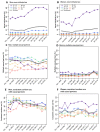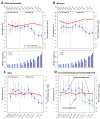HIV Prevention Efforts and Incidence of HIV in Uganda
- PMID: 29171817
- PMCID: PMC5627523
- DOI: 10.1056/NEJMoa1702150
HIV Prevention Efforts and Incidence of HIV in Uganda
Abstract
Background: To assess the effect of a combination strategy for prevention of human immunodeficiency virus (HIV) on the incidence of HIV infection, we analyzed the association between the incidence of HIV and the scale-up of antiretroviral therapy (ART) and medical male circumcision in Rakai, Uganda. Changes in population-level viral-load suppression and sexual behaviors were also examined.
Methods: Between 1999 and 2016, data were collected from 30 communities with the use of 12 surveys in the Rakai Community Cohort Study, an open, population-based cohort of persons 15 to 49 years of age. We assessed trends in the incidence of HIV on the basis of observed seroconversion data, participant-reported use of ART, participant-reported male circumcision, viral-load suppression, and sexual behaviors.
Results: In total, 33,937 study participants contributed 103,011 person-visits. A total of 17,870 persons who were initially HIV-negative were followed for 94,427 person-years; among these persons, 931 seroconversions were observed. ART was introduced in 2004, and by 2016, ART coverage was 69% (72% among women vs. 61% among men, P<0.001). HIV viral-load suppression among all HIV-positive persons increased from 42% in 2009 to 75% by 2016 (P<0.001). Male circumcision coverage increased from 15% in 1999 to 59% by 2016 (P<0.001). The percentage of adolescents 15 to 19 years of age who reported never having initiated sex (i.e., delayed sexual debut) increased from 30% in 1999 to 55% in 2016 (P<0.001). By 2016, the mean incidence of HIV infection had declined by 42% relative to the period before 2006 (i.e., before the scale-up of the combination strategy for HIV prevention) - from 1.17 cases per 100 person-years to 0.66 cases per 100 person-years (adjusted incidence rate ratio, 0.58; 95% confidence interval [CI], 0.45 to 0.76); declines were greater among men (adjusted incidence rate ratio, 0.46; 95% CI, 0.29 to 0.73) than among women (adjusted incidence rate ratio, 0.68; 95% CI, 0.50 to 0.94).
Conclusions: In this longitudinal study, the incidence of HIV infection declined significantly with the scale-up of a combination strategy for HIV prevention, which provides empirical evidence that interventions for HIV prevention can have a population-level effect. However, additional efforts are needed to overcome disparities according to sex and to achieve greater reductions in the incidence of HIV infection. (Funded by the National Institute of Allergy and Infectious Diseases and others.).
Figures



References
-
- PEPFAR 2016 Annual Report to Congress. The Office of the U.S. Global AIDS Coordinator and Health Diplomacy. February 2016. (Accessed at http://www.pepfar.gov/documents/organization/234744.pdf.)
-
- Jones A, Cremin I, Abdullah F, et al. Transformation of HIV from pandemic to low-endemic levels: a public health approach to combination prevention. The Lancet;384:272-9. - PubMed
MeSH terms
Substances
Grants and funding
LinkOut - more resources
Full Text Sources
Other Literature Sources
Medical
